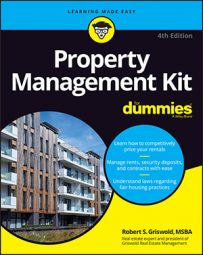As a property manager, you're always showing prospective tenants empty rental units. The following list can help you develop your pre-showing routine of tasks to take care of so that each unit shows its best side:
Remove all the prior tenants' personal possessions and trash after you have legal possession of the unit. If the unit was abandoned with furniture, clothing, or personal belongings, you must abide by any applicable state statute for removal.
Check all plumbing (toilets, faucets, and pipes) for proper operation. The faucets should have the proper pressure, and the sinks and toilets should drain adequately. Make sure that nothing leaks, including no moisture or drips under the sink. Change out old angle stops and install leak-resistant supply lines. If you're paying the water bill, this is a good time to change the ball cock assembly in the toilet tank; doing so may cut your costs by as much as 50 percent.
Test all appliances for proper operation. Try out all the appliances and run the dishwasher through a full cycle. Verify that the oven's drip pan, broiler pan, and racks are there. If you have a free-standing range, check that the anti-tip bracket is properly in place.
Examine all hardware. Confirm that the locks have been changed or rekeyed and are operational. Pay attention to all latches and catches, doorknobs and pulls, doorstops, and sliding doors.
Test all windows, insect screens, and window coverings. They should be clean, unbroken, weatherproof, secure, and properly operational. All window locks should work as well.
Check all walls, ceilings, and baseboards. The paint and/or wall coverings should provide proper coverage, without holes, cuts, scratches, nails, or bad seams. Look for signs of water intrusion and investigate and correct the cause of any such conditions.
Inspect all floor coverings. They should be clean and in good condition. The flooring should be properly installed, with no bad seams.
Check bathrooms. Thoroughly clean the toilet, tub, shower, sink, mirrors, and cabinets. Make sure the toilet paper holder and towel bars are clean and secure. Put a paper sanitary ring around each toilet seat and a new roll of toilet paper in each bathroom. Look under sinks for moisture and address any noted problems.
Inspect all closets and storage areas. Rods, closet dowels, hooks, shelves, lights, floors, and walls should be clean.
Check all counters, cabinets, doors, molding, thresholds, and metal strips. They should be clean and fully operational, presenting no hazards.
Test each smoke detector and carbon monoxide detector and check all lighting and electrical outlets, including GFCIs and circuit breakers, for proper operation.
Check all patios, balconies, and entryways. They should be clean and physically sound. Railings should also be secure.
Test the heating and air conditioning for proper operation. Be sure the thermostat, filters, vents, and registers are all in working order. Contact your natural gas supplier if you have any concerns about a gas appliance or heater.
Check the unit's curb appeal, including the exterior landscaping, driveways, and walkways. Keep them as tidy as possible.
Perform a final walk-through of the entire unit for appearance and cleanliness. Recheck the unit every few days it sits vacant.

